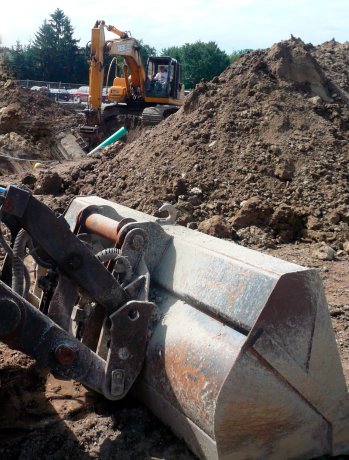In its heyday Atlas Steels Inc was the industrial heart of Welland, Ont., employing up to 3,000 people.
Its forerunner opened in 1918, one of the many manufacturing plants drawn by proximity to shipping and cheap and plentiful electricity. When operations shut down in 2004 a large portion of an adjacent site where the company dumped waste was found to be contaminated, creating a massive liability.
But where there’s a challenge, there’s opportunity and some out of the box thinking turned the Atlas Steels site from potential money pit to a revenue source and potentially a local landmark. The project won a 2016 Brownie award last year.
Looking back, Dan Degazio, Welland’s director of economic development, says the city was fearful local taxpayers could end up on the hook for a clean up. What Welland needed was an innovative solution, he says and it came about almost by serendipity.
"We’d split the site into nine parcels," he says.
"But the parcel with the former dump on it was a problem. No one really knew who owned it and Welland certainly didn’t want to own it because of the liability involved in clean up."
The site survey was grim: the site was full of steel manufacturing waste such as slag, dust, spent acids, concrete and waste oil. Further, oil was being discharged into a nearby waterway and there was caustic sludge.
Previous clean up orders had been ignored and it was in violation of its Certificate of Approval.
However, it had potential. The total licensed capacity of the landfill was 2,332,000 cubic metres but it had been filled with 735,000 cubic metres, leaving a capacity of 1,597,000 cubic metres on the 43.7 acre site.
Welland had already had many dealings with Walker Industries of nearby Thorold, a high respected company first established in 1887 involved in aggregates, construction, emulsions and environmental waste and recycling solutions.
"We’d been working with them on another project and in conversation it came around to us saying, ‘you know, we really have to work on something here in Welland with you,’ " says Degazio.
Walker is a fifth generation, family-owned Canadian company with facilities across Canada and the United States employing more than 600 people. It operates two landfills, a waste transfer facility, six bio-solids stabilization plants, two composting facilities, four food/residual organic processing facilities, several landfill gas renewable energy projects in Ontario and Manitoba, and a waste haulage company.
Coincidentally, about that time Degazio was suggesting they work together, Walker had been looking for a landfill site to support their own waste disposal division, says Mike Watt, Walker’s executive vice-president of environmental.
"About three years ago we’d been looking for a containment site for mildly contaminated soil," says Watt.
"So we started looking around to see where Environmental Compliance Approvals had been issued to see if we could find something."
The site was in tax arrears and the owners were bankrupt but Welland hadn’t taken action because they were unsure of the liability question.
Conversations started with the Ontario Ministry of the Environment, Welland and Walker to see if they could come up with a plan.
"We proposed to invest in the site, bring it up to standard as a landfill with proper containment technology and then to operate it as a landfill for a number of years," says Watt.
The city would get a portion of the revenues and at the end of the lifecycle, would be given the site to use for their own purposes.
"We invested about $12 million, stopped the leaching, cleaned up the groundwater and turned it around," Watt says.
"Then we got lucky. We got the job to take the fill from the new TTC streetcar barn on Toronto’s waterfront and so a lot of that 400,000 tonnes came here," he says, noting that the contract generated a steady cash stream, paying back Walker’s investment.
At the same time, not only did the burden of liability lift from Welland, the landfill became a source of revenue, says Degazio.
"We’ve been able to use that money to offset losses on recreational facilities and fund other programs without using the tax base," he says.
"It’s been a very good partnership and Walker is one of the best in the country to work with. The MOE stepped up, though slowly at first, because it was a very new concept, and now it’s become an asset in cleaning up other brownfields around Welland."
He says site owners who excavate contaminated fill get a reduced rate of $15 a tonne at the Atlas site, a price break which has encouraged them to take action.
"We really want them to keep it operating longer," he says, though they’ve become a victim of their own success.
"It looks like it will be full by 2018 or 2019."
Welland is currently looking at proposals for the site, post-landfill. One of the suggestions is to create a public passive park since it sits on a high point in the region and offers a spectacular view.
Watt says the success of the Atlas site has prompted Walker to continue to look for more sites in the area to follow the model they created in Welland.
"This really is a good model for others to use," he says.
The only drawback is that despite changes to Ontario environmental regulations, contaminated soil continues to be dumped in illegal locations such as farmer’s fields, he says.
"The regulations are there but there’s little enforcement outside of cities like Toronto," he says noting it makes it hard for those legitimate operations following the law.



Recent Comments
comments for this post are closed